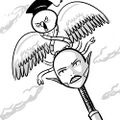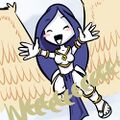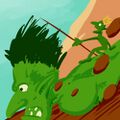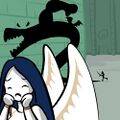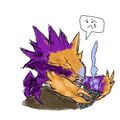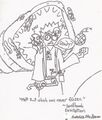Magic: The Gathering: Difference between revisions
("the stack" corrections. if you can explain it better (especially to someone who isn't familiar with mtg) or provide a better link, go for it.) |
|||
| Line 30: | Line 30: | ||
*'''Spell''' - Spells are any card that is currently on the stack. | *'''Spell''' - Spells are any card that is currently on the stack. | ||
*'''The Stack''' - This, children, is where all the real bullshit occurs. The stack is where any effect other than those that produce mana go to wait to '''resolve''', whenever an effect, such as playing a card, activating an ability of an artifact or creature, goes on the stack, all the players of the game receive '''priority''' in turn order. When a player has priority, no other player can act. When something is on the stack, only effects that are played at instant speed may be added to the stack, such as other abilities or instants themselves. You never have to put anything on the stack when you have priority, it just gives you the ability to respond to another players move. Effects on the stack resolve from the one to be put on last resolving first, this means that whenever you respond to your opponents move, your response will always take effect before his move. <br> For example if your opponent casts a spell to destroy one of your creatures in play, and you have the appropriate amount of mana to play a counter spell, you can tap your lands and add your counter spell to the stack, targeting your opponents destruction spell. When the stack resolves, your counter spell will be the last effect on the stack, and as such will resolve first, countering your opponents spell and saving your creature. Note that your opponent also receives priority again when you play the counter spell, meaning that it'll be possible for him to add a new spell to kill your creature after you have played the counter spell, meaning he'll kill your creature anyway. But then again, you'll receive priority again as well, and so on and so on. | *'''The Stack''' - This, children, is where [[https://www.wizards.com/Magic/Magazine/Article.aspx?x=mtgcom/feature/362#splitsecond almost]] all the real bullshit occurs. The stack is where almost any effect other than those that produce mana go to wait to '''resolve''', whenever an effect, such as playing a card, activating an ability of an artifact or creature, goes on the stack, all the players of the game receive '''priority''' in turn order. When a player has priority, no other player can act. When something is on the stack, only effects that are played at instant speed may be added to the stack, such as other abilities or instants themselves. You never have to put anything on the stack when you have priority, it just gives you the ability to respond to another players move. Effects on the stack resolve from the one to be put on last resolving first, this means that whenever you respond to your opponents move, your response will always take effect before his move. <br> For example if your opponent casts a spell to destroy one of your creatures in play, and you have the appropriate amount of mana to play a counter spell, you can tap your lands and add your counter spell to the stack, targeting your opponents destruction spell. When the stack resolves, your counter spell will be the last effect on the stack, and as such will resolve first, countering your opponents spell and saving your creature. Note that your opponent also receives priority again when you play the counter spell, meaning that it'll be possible for him to add a new spell to kill your creature after you have played the counter spell, meaning he'll kill your creature anyway. But then again, you'll receive priority again as well, and so on and so on. | ||
*'''Tap''' - Tapping is the act of turning a card 90 degrees, this is done to indicate that the card has been exhausted. You tap a land when you draw mana from it, you tap a creature to attack with it, and many abilities of creatures or artifacts require that you tap the card as well. | *'''Tap''' - Tapping is the act of turning a card 90 degrees, this is done to indicate that the card has been exhausted. You tap a land when you draw mana from it, you tap a creature to attack with it, and many abilities of creatures or artifacts require that you tap the card as well. | ||
Revision as of 00:23, 10 October 2013


Magic: The Gathering (or just "Magic") is a collectible card game created by Richard Garfield, and introduced to neckbeards everywhere in 1993. Despite the amount of RAGE the game has created over the years, it's still going strong. The game is currently in its 20th year of production with a large competitive following, consisting mostly of 40-year-old basement dwellers. Magic is notable for being the first CCG to make it big, and its influence can be seen in almost every CCG since. It also has fucktons of fluff that nobody really cares about. Ink-Eyes comes from here, and is only depicted in one card.
Despite sharing the same build of title of World of Darkness settings, M:TG has nothing to do with White Wolf.
Story
You are a Planeswalker, a wizard with near-limitless potential. One out of one million intelligent lifeforms carry the potential of becoming a Planeswalker, called the Spark. The vast majority of those live out their lives without even knowing of their potential. But a very small number of those, again one out of a million becomes far more. After a traumatising experience or a moment of supreme clarity the Spark ignites, giving the being power beyond nearly anything in the Multiverse.
A Planeswalker has several abilities. First it can travel between the Planes of the Multiverse through the Blind Eternities, the space between Planes in which they drift. Second they have great skill with channeling and using mana to cast spells and summon creatures. The Planeswalkers of old could do even more: they were gestalt forms of will, and could shapechange into anything they want. This also rendered them near indestructible, with their forms being easily replacable. They were also nigh-immortal, the only thing posing a serious threat to a Planeswalker was another Planeswalker.
The old Planeswalkers were akin to gods, and continued to be until roughly 4000 years after the ascention of Urza. Dominaria, the Nexus of the Multiverse had become something of a shithole because of various plotlines having royally screwed up the plane and rifts in time began to appear. After the sacrifices of many Planeswalkers these rifts were sealed in the Mending, an event that changed Planeswalkers for good. No longer gods amongst mortals, they were reduced to the power of mortal casters. They also lost their shapechanging and immortality, something that vexed many surviving Planeswalkers. Some like Nicol Bolas fought with tooth and nail to reobtain their powers, some like Liliana Vess made pacts with powerful creatures to be more powerful, and some like Sorin Markov accepted their loss. Then again Sorin's a vampire and so is naturally damn near immortal anyway, so his loss was rather less significant than others.
Gameplay wise there are four distinct eras:
- Pre-revisionist. Where the game started and still tried to find itself. Was broken as fuck; most decks consisted of a combination of Black Lotus, Channel and Fireball for plenty of turn 1 kills, cards were wordy as fuck and the art was between trippy and butt ugly. This consists of the Alpha/Beta/Unlimited editions, the old-timey stand-alone expansions (Arabian Nights, Antiquities, Legends, The Dark, Fallen Empires, That Set Which Will Not Be Named, the Ice Age Block (Coldsnap is a special case, while far older than the other two it is still part of the block) and the first two sets of the Mirage block. Back then there was not an awful lot of story on the cards (and no widespread Internet), so the main story had to be told through comic books. The story covered the war between two brothers, Urza and Mishra, the ice age that their war brought on, and how that was ended (with magic). All eras after this one are considered as post-revisionist, but that term is not used frequently.
- Weatherlight Saga. The magnum opus of M:TG, the Weatherlight Saga (starting from Weatherlight through the Rath, Urza, Masques and Invasion blocks) details the war between Urza and Phyrexia, the steampunk zombie hell that is trying to invade Dominaria at the behest of its god-king Yawgmoth. While mostly chronological, Urza's block takes place almost 900 years before Weatherlight. The story is about the crew of Skyship Weatherlight trying to gather the Legacy Weapon, a series of artifacts designed to be able to destroy Yawgmoth. After he manages to invade Dominaria the Legacy manages to do so at a great cost; all but a few of Weatherlight's crewmembers are dead, alongside large swathes of the planet and some of the most prominent Planeswalkers in the Multiverse, including Urza himself. This era also includes the 5th to 7th editions of core sets, the Portal Starter Sets and the Starter Year sets. From this point onward the story became told through a combination of cards and novels named after their expansion sets, of varying quality. The story is held in high regard by many older fans of the game.
- Post-Weatherlight Saga. Though no official name exists, the Post-Weatherlight saga consists of four storylines (divided over six blocks) detailing various planes of the Multiverse. These are the Mirrodin, Kamigawa and Ravnica blocks. Two of the other three blocks for the Odyssey (no not that one), a story taking plase on the continent of Otaria, which was largely untouched by Phyrexia. Here the Mirari landed, a magical orb that pumped massive amounts of mana into the world but would drive anyone who used it insane. After nearly destroying Otaria its owner, Karn, appeared, fixed it and brought it with him to his home world of Mirrodin. Here he turned the Mirari into Memnarch, which promptly went insane and nearly destroyed Mirrodin. Kamigawa is a world based on feudal Japan and was ravaged by enraged kami because someone had stolen the son of God. Ravnica took place on a world that was one big city: think Sigil but less deadly and bigger. Ravnica was governed by ten guilds, until a number of them tried to upset the status quo and promptly got roflstomped. The final block was that of Time Spiral; which returned to Dominaria. The plane was ravaged by magic and the actions of Planeswalkers, unraveling spacetime and threatening the entire Multiverse. Through the sacrifices of many notable Planeswalkers (including Lord Windgrace, Leshrac Nightwalker and Jeska) the Multiverse was saved in an event called The Mending, but The Spark was fundamentally altered. Planeswalkers were no longer gods: they were just very powerful mages capable of traveling the Planes after a quick ritual instead of on a whim. They also became bound to their bodies, no longer bodies shaped by pure will. The Multiverse was safe, but filled with enraged and depowered gods, like Nicol Bolas. This era also included the 8th to 10th editions of core sets.
- Post-Mending. This era has six blocks so far: Lorwyn/Shadowmoor, a plane that turns from bright upbeat British fairytale with facist Elves to a grim and gloomy spirit world filled with all sorts of nasties. The Alara block details the attempt of Nicol Bolas to slam five parts of a fractured plane together and feast on the released energy to make himself a god again: the slamming is a success but he fails when he is beaten by Ajani Goldmane. Zendikar is Australia on steroids and Call of Cthulhu; everything can and will try to kill you. On this world rested the Eldrazi, a race of non-beings that can unmake anything with a touch. Freed by the machinations of, once again, Nicol Bolas. They are fighting Gideon Jura who beat one to death with his bare hands. Scars of Mirrodin returns to, wait for it, Mirrodin, which is conquered and compleated by Phyrexia. Whoops. They currently have a spy amongst their ranks; Tezzeret, who was send there by, you guessed it, Nicol Bolas. Innistrad is a world of East-European gothic horror where vampires and werewolves run business It is one of the best sets ever with stuff like double-faced cards, monsters that get stronger when they die and awesome flavor. At the end of the block the Helvault was opened, a prison for lot's of demons. This was done by... no not Nicol Bolas. Not this time. It was Sorin Markov, who is an Innistrad native and first-generation vampire who created Avacyn (winged stabby Jesus) to prevent humanity from going extinct and with them the vampires until she got locked in the Helvault but now she's back with the demons... then there is a Return to Ravnica, where the Guilds have picked up business once again for the time being, evantually they run a world-wide maze to see who gets to take control of the city in the Jace Beleran does by becoming the guildpact (im as confused as you). finally there is Theros with the awesome flavor of Innistrad but with greek mythology and awesome mechanics to represent greek mythology, oh and Elspeth is there. This era also set off a new wave of core sets: after every cycle there is a new core set with a year in it, staring in Magic 2010 to Magic 2014 (to be released July 19th 2013) and adding a few new cards every series. This era also introduced Planeswalkers as cards: a new permanent type that functions as a crossover between a player, a legendary creature and an enchantment.
The game currently takes place in that era, where Planeswalkers have begun to rise in large numbers with the Multiverse's infinite secrets and powers at their feet. Here you decide what you will be.
Rules
Each player starts with a life total of 20, it is the goal of the game to reduce your opponent's life to 0 or less. Each player takes a turn until only one player is left in the game.
Game expressions
- Mana - Mana is the magical resource of the game, it is what you commonly use to play cards. Mana you have drawn from a source is kept in you mana pool, waiting for you to spend it. However, at the end of each phase and each step in a turn, your mana pool is emptied, so there's no saving up by constantly draining your lands.
- Spell - Spells are any card that is currently on the stack.
- The Stack - This, children, is where [almost] all the real bullshit occurs. The stack is where almost any effect other than those that produce mana go to wait to resolve, whenever an effect, such as playing a card, activating an ability of an artifact or creature, goes on the stack, all the players of the game receive priority in turn order. When a player has priority, no other player can act. When something is on the stack, only effects that are played at instant speed may be added to the stack, such as other abilities or instants themselves. You never have to put anything on the stack when you have priority, it just gives you the ability to respond to another players move. Effects on the stack resolve from the one to be put on last resolving first, this means that whenever you respond to your opponents move, your response will always take effect before his move.
For example if your opponent casts a spell to destroy one of your creatures in play, and you have the appropriate amount of mana to play a counter spell, you can tap your lands and add your counter spell to the stack, targeting your opponents destruction spell. When the stack resolves, your counter spell will be the last effect on the stack, and as such will resolve first, countering your opponents spell and saving your creature. Note that your opponent also receives priority again when you play the counter spell, meaning that it'll be possible for him to add a new spell to kill your creature after you have played the counter spell, meaning he'll kill your creature anyway. But then again, you'll receive priority again as well, and so on and so on.
- Tap - Tapping is the act of turning a card 90 degrees, this is done to indicate that the card has been exhausted. You tap a land when you draw mana from it, you tap a creature to attack with it, and many abilities of creatures or artifacts require that you tap the card as well.
- Ability - Abilities are found in a permanent's text field. Abilities can be either activated or triggered abilities. An activated ability is noted for having a cost followed by a colon followed by the effect of the ability. For example, "Tap : Draw a card, then discard a card ." Triggered abilities however, will be added to the stack whenever a certain condition is met, for example "Whenever you gain 1 life, draw a card". A triggered ability can be triggered as many times as the condition for it is met, and an activated ability can be activated as many times as you can possibly pay the cost.
- Hand - No, not that hand, stupid. Your hand of cards. You can normally only have 7 cards in your hand at any time, and your hand of cards is kept so your opponent can't see it. You start the game with a hand of 7 cards, and you draw 1 card each turn, there are cards that let you draw more cards however.
- Library - You library is your deck of cards, it must contain no less than 60 cards, and it is often ideal to not include more than 60 cards either. If you are asked to draw a card and you cannot because there are no more cards left in your library, you lose the game, just as if you had hit 0 life.
- Graveyard - This is where used sorceries, instants and destroyed cards go. Some cards are able to return cards from here, but normally they just stay dead. This is a place of magic and wonder for any deck that runs revive. Until someone plays Samurai of the Pale Curtain...
Structure of a turn
The first step in a turn is the untap step, here all the cards in play that are tapped untapped. The next step is your upkeep, nothing happens here by default, it is only in place for some cards to trigger different effects at the start of your turn.
After your upkeep is your draw step, here you simply draw a card from the top of your library.
Next is your first main phase, here you can play any spells that are played at sorcery speed, this is things such as artifacts, creatures, enchantments, planeswalkers, land and sorceries themselves.
After your first main phase is your combat phase, this is broken up into several subphases itself. The first thing to happen is that you declare any creatures you want to attack to attack by tapping them, you opponent is then given the choice of blocking your creatures. Only an untapped creature can block, and a creature can only participate in one block each combat. However, several creatures can be picked to block the same creature at once, meaning that it is possible to 'gang up' on attackers in order to kill them. When creatures are in combat with each other they will deal each other damage at the same time, meaning that two 1/1's will kill each other at the same time. In the case of multiple creatures blocking one creature, the attacker assigns the damage that his creature would deal out to the blocking creatures as he wishes, for example a 2/2 blocked by two 1/1's could deal 1 damage to both creatures and kill them both. Any unblocked creatures will deal their damage to the opponent. Once all damage has been assigned, the clean up step follows, where all creatures that have taken lethal damage will be sent to their owner's graveyards.
After combat you have your second main phase, where you can do exactly the same as in the first.
After the second main phase, you have the end of turn step, pretty much the same deal as with the upkeep, nothing really happens here unless a card says so. Lastly, after your end of turn step, you discard down to the maximum hand size if you have exceeded it, so if you for example have 9 cards in hand, you will have to discard 2 of them to meet the required of 7.
Types of cards
The game of Magic contains several different supertypes of cards:
- Lands - Lands are the player's most basic resource, and they allow the player to play their other cards that have a mana cost.
- Creatures - Creatures are the players soldiers and guardians, they primarily participate in combat, although as with all things in Magic, there are many exceptions this. Creatures have many subtypes, these are commonly referred to as creature types, most creatures have a race and a profession creature type, for example "Creature - Human Warrior". Creatures have a toughness and a power score, portrayed as P/T on the bottom right corner of the card. Power determines the amount of damage the creature can cause in combat, whereas toughness is how much damage it can take before it is destroyed. Damage assigned to a creature is cleared at the end of each turn, meaning that if a creature isn't killed by the amount of damage it has sustained, it'll return to its full toughness at the end of the turn. This means that the same creature will often participate in several combat steps before it is finally killed. Damage assigned to players however, is never healed by any other means than other cards that give the player an amount of life upon being played.
- Enchantments - These are raw magic that you create, they can do all different kinds of things, and generally have a constant effect on the game, until they are destroyed by your opponent. There are global and local variants of enchantments, the local being a subtype called auras, these are attached to other cards in play to enhance them or weaken them. A lot of competitive players dislike auras since they are destroyed if their 'host' is destroyed, meaning that it is easier for your opponent to make a lot of you cards obsolete by destroying one card.
Example of an Enchantment card.
- Sorceries - Sorceries are spells that you can only cast on your own turn, and when nothing is on the stack, they'll have some kind of immediate effect on the game, but they are not persistent like enchantments. This means that it is common for sorceries to simply just destroy something else in play or to give a temporary boost to a creature or something like that. The more massive destructive effects in the game are commonly found in sorceries, such as globally destroying all lands or creatures in play.
- Instants - Just like sorceries, however an instant can also be played in an opponent's turn, they'll often do the same as sorceries, but stuff like counter magic, that is a spell that prevents your opponent's spell from resolving, are only instants.
- Artifacts - All kinds of magic items, like a staff or some other kind of stuff. Normally this is equipment for the player himself, but some artifacts can be equipped by the player's creatures, making them work like auras, only they do not need a 'host' to be in play, and as such are a lot more persistent than auras. Some artifacts are also creatures, this is stuff like golems or other kinds of magical constructs. Artifacts are colourless, meaning that any colour can use any artifact, since they do not have a coloured mana cost.
- Basic - A supertype currently found only on land cards. A deck can contain any number of the same basic card.
- Legendary - Much like Basic, Legendary only appears together with another supertype. There can be only one of the same legendary card in play at once, and if another is played while one is in play they both end up in their owners graveyards. Legendary cards are often stuff like characters from the plot line of Magic, or somehow else very special things like specific places in the case of legendary lands.
- Tribal - A newcomer among the supertypes, a Tribal card lets a noncreature card have creature types. For example, a card that would allow you to destroy a goblin card would work on any goblin creature, as well as a Tribal Enchantment - Goblin.
- Planeswalker - Another newcomer, a Planeswalker is similar to an enchantment. Planeswalkers come into play with a certain amount of loyalty counters on them. Once per turn a planeswalker can use one of its activated abilities during his main phase whenever he may play a sorcery, either adding or subtracting the indicated amount of counters. A planeswalker can be targeted for either spells or abilities that deal damage, and can be targeted in an attack phase like a player. For each damage a planeswalker takes, instead remove that many loyalty counters. If a planeswalker has no loyalty counters left on it, it is destroyed. Similarly to the Legendary supertype, if two planeswalkers that share a planeswalker type are in play, they are both destroyed. Planeswalkers can do some really awesome shit, such as create 5 4/4 dragons or force your opponent to mill 20 cards from their library. Problem is, since you can't do things like make them indestructible, keeping one alive can be a royal pain in the ass.
Example of a Planeswalker card.
Colors of magic

It features the trademarked pentagram of the colours. The pentagram is set up in such a way that colours that have parts of their philosophies in common are adjacent to each other, whereas colours that oppose each other are positioned opposite of each other.
As well as having different types of cards, the game of Magic has 5 different colors to choose from when building a deck. It is important to have the appropriate type of land for the colour of magic that you are playing with, since no basic land except a mountain can produce red mana, which is needed to play red spells. Certain effects are associated with certain colours, and only rarely if ever appear in the others - this is to ensure that the colours feel different to play, and that there is a point of having different colours in the first place.
- White - This is the mostly goody-two-shoes of the colour pie, white often prevents damage to creatures and restore life to players. As excels with instant, sorceries, and enchantments that get rid off opposing creatures, with one of their main schticks being that the remove creatures from the game rather than sending them to the graveyard. It's also the color of genocide and fascism. It has a general philosophy of having a large amount of small creatures instead a few big ones. White embodies law, order, community, healing, and light. The symbol for white is a sun. The white lands are plains. White's Planeswalkers are either heroic and otherwise benevolent individuals such as Ajani Goldmane, Elspeth Tirel and Commodore Guff, or fanatical assholes like Konda and Elesh Norn.
- Blue - Blue is the color of logic and wizardly magic. It is the best color at things like countermagic, drawing cards, and using minor trickery to be a general pain in the butt. These things make blue the most effective color when used on its own, and the most hated by other players because blue played right will keep them from doing anything with their counter cards and will never run out of them, and blue players have a tendency to complain when WoTC tries to do something to balance the counter spells. Thankfully, blue's creatures tend to the least effective at killing the opponent, in terms of strength and abilities, and blue also lacks the ability to deal with things if it can't counter them. Blue concerns itself with such things as logic, water, science, knowledge, divination, and air. The blue symbol is a drop of water. The blue land is an island. Blue's most foremost Planeswalkers include Jace Beleren, Tezzeret and Bo Levar.
- Black - Black is the more diabolical of the colors. It is the color of social progress, individuality, moral relativism and capitalism, all evil things Amurica hates. It often has the ability to emulate other colors to a lesser degree at a cost of the player's own life. The more powerful black creatures sometimes turn on their player. It also contains lots of abilities that require sacrificing creatures, forcing the opponent to sacrifice creatures, killing opposing creatures, and the best discard abilities. As an intentional weakness, black lacks any significant artifact or enchantment kill. Black contains such things as sickness, destruction, necromancy, death, darkness, and corruption. A skull is the symbol for black. The black land is a swamp. Black has spawned many infamous Planeswalkers such as Leshrac, the Walker of the Night; Tevesh Szat, the Doom of Fools; Liliana Vess and Nicol Bolas (well he's actually multi-colored), the Eternal Serpent and Lord of the Blind Eternities.
- Red - Red is the color of passion and rage. Red contains some of the more self destructive cards of the colors, but the power of the effects usually make up for it. Many of red's spells focus on directly damaging the opponent, players call them "burn spells", and in fact it's completely viable to run a red deck with no creatures and just burn spells. Creature wise, red has the cheapest in game. The domain of red is such things as speed, destruction, fire, lightning, dragons, and recklessness. Red's symbol is a ball of fire. The red land is a mountain. Some of Red's most famous Planeswalkers are Jaya Ballad, Lord Windgrace of Urborg and Chandra Nalaar.
- Green - Green associates itself with nature and the cycle of life. It usually has the most powerful and straight-forward creatures, which also have the best ratio of power and toughness for the mana cost. Green contain cards that can increase the strength of your creatures, cards that give you more mana more quickly and give you access to the other colors of mana, and cards that let you create and profit from large numbers of small creatures or small numbers of very large creatures. Green is the least common color run on its own because it needs to use small easy to kill creatures to accelerate its to get shit done, but is commonly put in other decks as a side color. The green symbol is a tree. The green land is a forest. Green's famous Planeswalkers include Garruk Wildspeaker, Nissa Revane, Kristina of the Woods and Freyalise.
- Colourless - Mana of any color can be used as colourless mana. This is useful to ease the stress of colored mana requirements in multicoloured decks, and making cards that can fit in decks of any color - Artifacts are usually colorless. Artificial creatures cannot become Planeswalkers (but this does not stop them from trying to become them, as Memnarch has demonstrated), but they can inherit or obtain the power somehow: Karn the silver golem is as far as known the only one to have done so.
It is possible to build decks that are a mix of more than one color - in fact there are many spells that require anything from two to five different colors of mana to play. It is however not advisable to have more than 3 colours in a single deck unless you know what you are doing, since it'll begin to become a problem to get access to all the different colours of mana you need during play. This means you'll be left with a hand full of cards you can't play, and a table full of lands you have no use for - not a good position to be in.
Players

The developers of Magic have put out their 3 archetype players:
- Timmy - The player who just wants to experience something cool, something you can tell stories about. Often it's through casting gigantic creatures and game-changing spells, not caring that they're frequently too expensive to be much good at winning the game. But social gamers or even griefers are also a type of Timmy.
- Johnny - A combo player, these are the guys who'll spend days looking through cards to find a bizarre combo that makes them win the game. They often end up building decks that doesn't participate in the game itself, and are more oriented on getting their combo into play, turning the game into a sort of solitaire.
- Spike - The competitive player of the bunch. They'll build decks to win and only play to win, almost none of them are in it for the fun, and often turn the game into an obnoxious competition, even outside of tournaments.
The three archetypes mix and match, meaning that it is possible to be a Johnny-Timmy player, aiming to make some kind of combo that'll give you a million life and an army of 100/100 creatures or some other kind of stupid nonsense.
Recently, it has come to light that there are 2 more pseudo-archetypes, though these aren't really archetypes proper. The types here are on a separate axis than the aforementioned four. They are as follows:
- Vorthos - Vorthoses care about flavour and the story part of the game. They'll build a deck that re-enacts the forces Urza rallied to fight the Phyrexians. Fluff is of key importance in the mind of a Vorthos. Stories, art, flavour text, and block novels are all things that a Vorthos focuses on.
- Melvin - On the opposite side of this spectrum lies Melvin. Melvins love to deconstruct the rules, find out why things tick. A Melvin will base a deck on retarded shit like banding, or some sub-clause of an obscure part of the comprehensive rules. Melvins love reading the logs and development process of various cards.
See also
- Vampire: The Eternal Struggle - Another card game by Richard Garfield.
- Magic: the Gathering RPG - a /tg/-made RPG with mechanics based on the game.
- M/tg/
External Links
- Official site
- Rulebook
- magiccards.info - A card database.
- MTG Salvation - A Magic fansite.
- Star City Games - A huge Magic site, they buy and sell cards, have articles, deck lists, everything.
Gallery
-
Yes, in MtG, birds can be equipped with the heads of dead monster girls, it's good stuff.
-
Any character can be cutesified. Angels are extra weak against that kinda thing
-
The Legend Rule is kinda silly.
-
So MANY RATS!
-
No goblin resists the sled!
-
Dragon Shadow works against paragons of Justice.
-
Black has a bunch of undead teachers who can help you on your quest for ultimate power.
-
How could you hate this guy? He loves his rat.
-
Blue has crabs.... These crabs are smarter than you might think
-
A hedron crab's life does have sadness every so often.
-
A proper vintage artifact player can pull stuff even against a broken deck.
-
Looks like one of the people working under Steve Argyle is about to be promoted.
-
-
| Card Games | |
|---|---|
| Collectible Card Games: |
Call of Cthulhu - Cardfight!! Vanguard - Fire Emblem Cipher Force of Will - Jyhad - Magi-Nation Duel - Magic: The Gathering Netrunner - Pokémon - Star Wars: Destiny CCG (Dead) - Yu-Gi-Oh |
| Other Card Games: |
1000 Blank White Cards - 7th Sea - Apples to Apples - Bang! Cards Against Humanity - Coup - Decktet - Dominion - Dvorak F.A.T.A.L. - Keyforge - Mafia - Mag Blast - Mao - Munchkin Race for the Galaxy - Sentinels of the Multiverse - Tanto Cuore |
| Traditional Card Games: |
Bridge - Cribbage - Mahjong - Solitaire/Patience - Poker - Rummy - Tarot |
| Settings of Magic: The Gathering | |
|---|---|
| Pre-revisionist: | First Magic Sets - First Urza Block - Arabian Nights Legends - Homelands - Ice Age - Mirage |
| Weatherlight Saga: | Portal Starter Sets - Second Urza Block Tempest Block - Masques Block - Invasion Block |
| Post-Weatherlight: | Otaria Block - Mirrodin - Kamigawa - Ravnica - Time Spiral |
| After the Mending: | Lorwyn - Alara - Zendikar - New Phyrexia Innistrad - Return to Ravnica - Theros - Tarkir - Eldraine - Ikoria |
| Two-Block Paradigm: | Kaladesh - Amonkhet - Ixalan |
| Post Two-Block Paradigm: | Eldraine - Ikoria - Kaldheim - Strixhaven |
| Never in a standard set: | Fiora (Where the Conspiracy sets take place) - Kylem (Battlebond) |
| Planeswalkers of Magic: The Gathering | |
|---|---|
| Original Five: | Ajani Goldmane - Chandra Nalaar Garruk Wildspeaker - Jace Beleren - Liliana Vess |
| Alara: | Elspeth Tirel - Nicol Bolas - Sarkhan Vol - Tezzeret |
| Zendikar: | Gideon Jura - Nissa Revane - Sorin Markov |
| Scars of Mirrodin: | Karn - Koth of the Hammer - Venser |
| Innistrad: | Tamiyo - Tibalt - Davriel Cane |
| Return to Ravnica: | Domri Rade - Ral Zarek - Vraska |
| Theros: | Ashiok - Kiora - Xenagos - Calix |
| Tarkir: | Ugin - Narset |
| Kaladesh: | Dovin Baan - Saheeli Rai |
| Amonkhet: | Samut |
| Other: | Dack Fayden - Vivien Reid - Kaya |
| Commander 2014: | Daretti - Freyalise - Nahiri - Ob Nixilis - Teferi |
| Pre-mending: | Bo Levar - Commodore Guff - Jaya Ballard - Urza |
| Forgotten Realms: | Ellywick Tumblestrum - Bahamut - Lolth - Zariel - Mordenkainen |
| Planeswalker Groups: | The Gatewatch |
